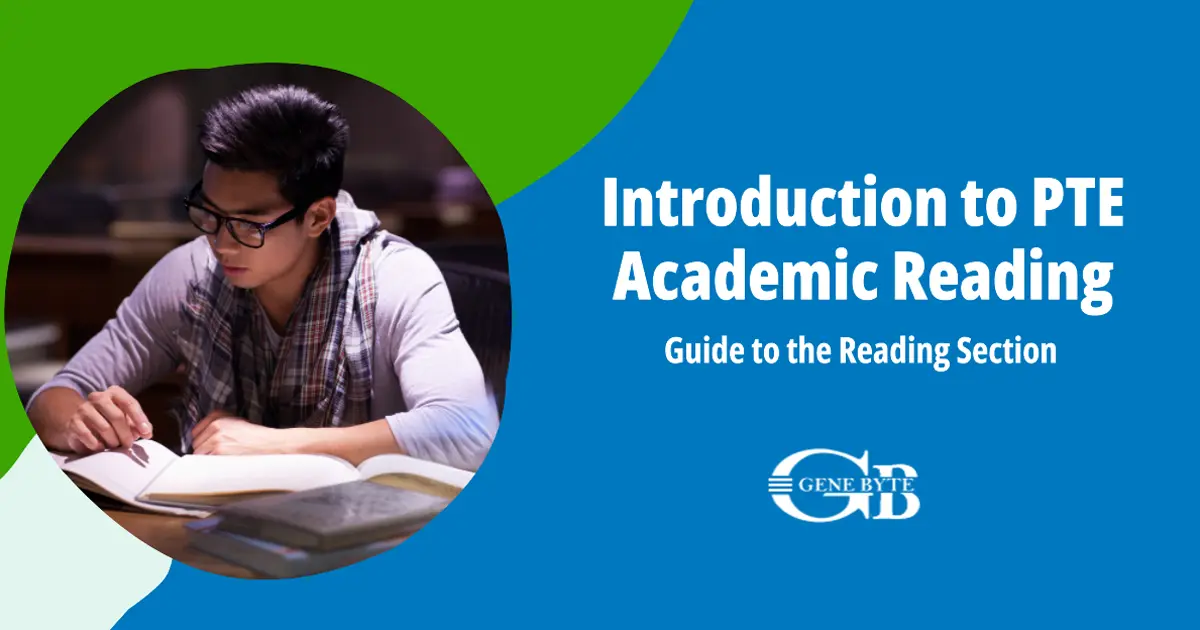Mastering PTE Academic Reading is a strategic endeavor. With Genebyte's AI-enhanced solutions, every reading challenge is an opportunity to learn, practice, and score higher.
The Reading section of the PTE Academic exam is challenging for students and teachers. Genebyte's AI-driven platform helps educators guide students effectively.
Key Takeaways:
- Support for Educators: Genebyte offers tools and resources to navigate the Reading section.
- Customized Training: Our evaluation portals provide tailored subscriptions for each institute.
- Simplify the Reading Section: Understand its various components clearly.
- Understanding Complex Scoring: Focuses on accuracy, content, fluency, and relevancy.
- Improve Teaching Strategies: Prepare students for tasks like Fill in the Blanks and Multiple-choice questions.
- Boost Student Success: Use Genebyte's tools to enhance teaching and student performance.
With Genebyte's advanced tools, educators can make the Reading section easier for students, leading to better results in the PTE Academic exam.

Introduction to PTE Academic Reading
Overview of PTE Academic as a Computer-Based Test
In the landscape of English proficiency assessments, PTE Academic stands out as a comprehensive computer-based test, embraced worldwide for its precision and reliability. The PTE Academic exam is segmented into four primary sections—Speaking, Writing, Reading, and Listening—each comprising various question types, meticulously designed to evaluate different facets of English language proficiency. The unique scoring system takes into account accuracy, content, fluency, relevance, and adherence to response constraints such as word limits. The score weightage varies across the 20 question types, compelling students to strategically allocate their efforts to excel in each.
Importance of Reading in PTE Academic
The Reading section, specifically, is a test of mettle and acumen, where the ability to decode and comprehend texts becomes the cornerstone of success. It is not merely about understanding passages but also about demonstrating a nuanced grasp of the language in multiple formats. This is where Genebyte's technology becomes an invaluable ally to educators, offering an interface that simulates the PTE Academic's environment, allowing for a focused and effective teaching approach.
The Structure and Content of the Reading Section
Encompassing five distinct question types, the Reading section challenges test-takers with tasks such as Reading and writing: Fill in the blanks, Multiple-choice, choose multiple answers, Re-order paragraphs, Reading: Fill in the blanks, and Multiple-choice, choose single answer. With a combined time allocation of 29 to 30 minutes to tackle 13 to 18 questions, students must not only be adept at reading but also at managing their time efficiently. The total score for these tasks amounts to 45, signifying the high stakes attached to this section.
In the context of Genebyte's offerings, our AI-driven solutions are tailored to address the intricacies of these question types. The platform facilitates an analytical understanding of each task, enabling teachers to guide their students in honing the skills necessary to navigate the Reading section's challenges successfully. Through our technology, educators can provide their students with a strategic edge, equipping them with the confidence to secure their desired scores.

Reading and Writing: Fill in the Blanks
Task Description and Skills Assessed
The Reading and Writing: Fill in the Blanks item of PTE Academic is a testament to the multifaceted nature of language proficiency. In this task, a text passage is displayed on screen, peppered with several blanks that the test-taker must fill by selecting the correct words from a drop-down list of options. This exercise assesses a range of skills: from vocabulary and grammar to a deeper understanding of context and coherency within a passage. Teachers must emphasize these competencies to ensure their students are well-prepared for this challenge.
Scoring Criteria and Importance
The significance of this task within the Reading section cannot be overstated—it holds a high weightage and is marked partially. Each correctly filled blank contributes to the overall score, allowing test-takers to accumulate points progressively. The task typically includes 5 to 6 questions, with a paragraph length of up to 300 words and 4 to 6 blanks to complete. Each blank offers 4 to 5 options, making discernment crucial for success.
To support educators in cultivating these critical reading and writing skills among students, Genebyte's SaaS solutions offer a unique value proposition. Our AI-enhanced platform mirrors the PTE Academic's testing conditions, enabling teachers to deliver targeted instruction that bridges the gap between understanding and application.
Real-Life Application and Tips
To illustrate the practical application of our technology, consider the following table that encapsulates the Reading and Writing: Fill in the Blanks task:
| Number of Items | Text Length | Number per Question | Type of Answer | Time Allowed | Importance |
|---|---|---|---|---|---|
| 5 to 6 | Up to 300 words | 4 to 6 blanks | Drop-down list | 180 seconds | High |
Teachers can leverage Genebyte's software to create custom practice sessions that emulate these parameters, providing students with a realistic and rigorous preparation environment.
Moreover, teachers should guide students to:
- Eliminate incorrect options to reduce confusion.
- Pay close attention to tenses and grammatical structure.
- Avoid selecting all options in multiple-answer tasks to prevent unnecessary point deductions.

Multiple-Choice: Choose Multiple Answers
Task Description and Skills Assessed
The Multiple-choice, Choose Multiple Answer task in the PTE Academic Reading section is an exercise in critical reading and analytical thought. Students are presented with a text of up to 300 words and are tasked with answering a question about the content or tone by selecting more than one correct response from several options. This task assesses a candidate's ability to understand, interpret, and evaluate the text. It requires not just comprehension but also the ability to discern subtle nuances and apply higher-order thinking to identify all valid answers.
Scoring Criteria and Importance
This question type is particularly challenging due to its 'negative marking' system. Incorrect answers will result in points being deducted from those awarded for correct responses. It is therefore essential for students to be cautious and selective, ensuring they can differentiate with precision between the correct and plausible but incorrect options. Despite its complexity, this task carries a low weightage in the overall Reading section score, emphasizing the need for strategic prioritization during exam preparation and practice.
Genebyte's SaaS platform is engineered to support educators in reinforcing these skills. Our analytics allow teachers to identify student weaknesses in multiple-choice scenarios and provide targeted practice, harnessing the power of AI to simulate the subtleties of the actual test environment.
In-Context Application
A well-structured table can assist educators in visualizing the task breakdown and preparing teaching strategies accordingly:
| Question Type | Text Length | Options | Time Allocation | Scoring Impact | Importance |
|---|---|---|---|---|---|
| Multiple-Choice: Choose Multiple Answers | Up to 300 words | 5 to 7 | 90 Seconds | Negative Marking | Low |
By integrating this structure into practice sessions, teachers can cultivate a test-taker's ability to swiftly analyze texts and make informed decisions under time constraints.

Re-order Paragraphs
Task Description and Skills Assessed
In the Re-order Paragraph task of the PTE Academic Reading section, candidates are presented with a jigsaw puzzle of text boxes that must be arranged in a logical order to reconstruct the original passage. This segment evaluates critical cognitive skills, such as the ability to understand the cohesion and coherence in texts, and the capacity to identify logical sequence and thematic links between sentences and paragraphs. With typically 2 to 3 items of up to 150 words each, this task requires not just comprehension but a keen eye for textual flow and narrative structure.
Genebyte's B2B SaaS platform precisely targets these skills. Our software simulates the test's interface, providing teachers with a tool that offers authentic practice opportunities. Through real-time feedback and intelligent guidance, educators can help students build the necessary competencies to excel in this challenging task.
Table of Task Characteristics
To aid educators in their instructional strategies, here is a summarized table of the task characteristics:
| Task Type | Number of Items | Text Length | Answer Method | Time Allocation | Scoring Impact | Importance |
|---|---|---|---|---|---|---|
| Re-order Paragraphs | 2 to 3 | Up to 150 words | Drag and Drop | 120 Seconds | Binary | Medium |
Genebyte's platform allows educators to customize practice sessions to reflect these parameters, enabling a tailored teaching approach that meets each student's individual needs.
Practical Implications and Educator Actions
In practice, educators can utilize Genebyte's analytics to:
- Track student progress on Re-order Paragraphs tasks.
- Provide insights into common errors and misconceptions.
- Develop targeted exercises that improve students' abilities to discern logical order in texts.

Reading: Fill in the Blanks
Task Description and Skills Assessed
Reading: Fill in the Blanks within the Reading section of PTE Academic is a task that challenges test-takers to demonstrate their lexical resource and syntactic awareness. A given text, appearing on-screen, contains several blanks that must be completed using words from a provided list. This task evaluates a student's understanding of vocabulary, grammar, and the ability to contextually choose the appropriate word to maintain the coherence and integrity of the text. It is a direct reflection of a candidate's reading and language comprehension capabilities, as well as their attention to detail.
Scoring Criteria and Importance
In terms of scoring, this task is marked on a partial credit system, where each correctly filled blank contributes to the student's overall Reading score, making it a high-importance question type. It is also a direct measure of a student's capacity to use collocations effectively, an aspect pivotal to demonstrating proficiency in English.
Genebyte's B2B SaaS platform enriches this learning experience by providing an environment where educators can replicate the conditions of the PTE Academic test. This not only prepares students for the type of content they will face but also familiarizes them with the test dynamics.
Table of Task Features
Here's a tabular representation of the task features for 'Fill in the Blanks':
| Task Type | Text Length | Number of Blanks | Answer Options | Importance |
|---|---|---|---|---|
| Reading: Fill in the Blanks | Up to 300 words | 4 to 5 blanks | Multiple Choices | High |
Integrating Task Practice into Curriculum
Teachers can utilize Genebyte's analytics to create and manage targeted practice sessions for their students, ensuring they:
- Engage with texts of appropriate complexity.
- Develop a keen sense of word-choice and collocation usage.
- Receive immediate, corrective feedback to guide their learning path.

Multiple-Choice: Choose Single Answer
Task Description and Skills Assessed
The Multiple-choice, Choose Single Answer task is a critical component of the PTE Academic Reading section, requiring examinees to read a text and select the most appropriate response to a question based on the content or tone of the text. This task assesses a student's reading comprehension, including their ability to grasp the main idea, determine the author's tone, and infer meaning from the context. Typically, students encounter 1 to 2 questions of this type, dealing with texts up to 300 words, and must select a single response from 3 to 5 options provided.
Scoring Criteria and Importance
Each correct answer in this task is scored on a 'correct or incorrect' basis, meaning there is no partial credit for close answers. This emphasizes the need for precise understanding and critical evaluation of the text. Although it carries a low weightage in the overall Reading section score, mastering this question type is essential for achieving a comprehensive reading proficiency, which is indispensable for a high overall PTE score.
Genebyte's SaaS solution is designed to empower educators with the tools to effectively prepare students for this task. Our platform offers practice materials that mirror the actual PTE Academic test environment, including time constraints and question formats, to provide a realistic and beneficial practice experience.
Strategies for Success
- Focus on high-weightage question types during preparation.
- Utilize practice tests to familiarize students with the format and time management.
- Employ immediate feedback features to correct misunderstandings in real-time.
By integrating these strategies into their curriculum, educators can ensure their students are well-prepared for the Multiple-Choice: Choose Single Answer task and are on the right track to achieving their desired PTE Academic scores.

The Integrated Nature of the Reading Section
How Reading Impacts and Contributes to Other Sections, Especially Writing
In the PTE Academic, the Reading section is not an isolated module; it's an integrated component that interweaves with the Writing section, enhancing the composite skill score. This integrated scoring paradigm means the Reading section not only assesses a student's ability to comprehend text but also contributes to the evaluation of their written communication. Points from the Reading section have a ripple effect, influencing scores in the Speaking and Listening sections, and vice versa. However, it is the Writing section that receives a direct impact from the Reading module, underlining the interconnectivity of language skills in the PTE Academic test.
The Significance of Understanding Integrated Scoring for Effective Teaching
For educators, grasping the concept of integrated scoring is crucial. It necessitates a teaching approach that transcends compartmentalized instruction, favoring a more holistic method that underscores the relationship between reading comprehension and written expression. This understanding allows for the crafting of teaching strategies that not only prepare students for individual sections but also equip them to excel across the test as a whole.
Genebyte's B2B SaaS offering is specifically designed to acknowledge and support this integrated approach. Our AI-driven practice software includes an AI agent that provides in-depth explanations for reading questions, facilitating a deeper understanding of how reading skills directly correlate to writing proficiency.
Practical Implementation in Genebyte's Platform
Within Genebyte's ecosystem, the integrated scoring system is reflected in the analytics and feedback provided to educators, enabling them to:
- Identify how reading comprehension strengths and weaknesses may affect writing scores.
- Implement targeted practice that improves reading strategies which are beneficial for writing performance.
- Customize practice sessions that reflect the integrated nature of the test, thus preparing students for the scoring system they will encounter.

Strategies for Handling Time Pressure
Time Management within the Reading Section
Effective time management is pivotal in the PTE Academic Reading section. Test-takers are allocated a 'total' time of 29 to 30 minutes to answer 15-20 questions. This constraint demands strategic pacing and the ability to quickly process information. We at Genebyte recognize the significance of time efficiency and incorporate strategies into our training materials that aid in managing this critical aspect of the test. By following the time management strategies laid out in our comprehensive guides, students are better positioned to complete the Reading section within the allotted time, maximizing their scoring potential.
Recommended Time per Question and Fast Reader vs. Slow Reader Considerations
Genebyte's analytics have allowed us to formulate a 'recommended time management' structure for the Reading section. Below is a table that outlines the advised time allocation per question type, catering to both fast and slow readers:
| Item Type | Fast Reader Time | Slow Reader Time | Recommended Time |
|---|---|---|---|
| Reading and writing: Fill in the blanks | 2 min | 4 min | 3 min |
| Multiple-choice choose multiple answer | 2 min 30 sec | 5 min | 1 min 30 sec |
| Re-order paragraph | 1 min | 2 min | 2 min |
| Reading: Fill in the Blanks | 1 min | 1 min 30 sec | 2 min |
| Multiple-choice choose single answer | 1 min | 3 min | 1 min |
Understanding that reading speed and comprehension vary among individuals, our platform customizes practice sessions to improve both speed and accuracy. Through adaptive exercises and real-time feedback, students can enhance their skimming and scanning abilities, crucial skills that Genebyte's software helps to develop and refine.
Genebyte's Role in Enhancing Time Management Skills
Genebyte's platform plays a vital role in enhancing these time management skills by providing:
- Simulated test environments to practice pacing.
- Immediate feedback on time spent per question, encouraging faster decision-making.
- Tools for educators to monitor student progress and identify areas where speed can be improved.
This focus on time management aligns with our commitment to offering a solution that not only teaches but also equips students with the necessary skills to excel under exam conditions.

Essential Reading Skills for PTE Academic
Importance of Skimming and Scanning Techniques
Skimming and scanning are invaluable techniques in navigating the time-bound nature of the PTE Academic Reading tasks. Skimming enables test-takers to quickly identify the main ideas and gist of a passage, which is crucial when passages can run up to 300 words and time is limited. Scanning allows students to locate specific information and answer questions efficiently. At Genebyte, we emphasize these techniques in our training programs to ensure that students can handle the time pressure effectively and maximize the number of questions they can answer correctly within the allotted time.
The Role of Paraphrasing, Proofreading, Vocabulary, and Collocations in Reading Success
To further enhance reading proficiency, Genebyte's platform focuses on the development of skills such as paraphrasing, proofreading, and vocabulary usage, including the correct application of collocations. These skills are essential for students to navigate the Reading section successfully. Paraphrasing aids in understanding questions and prompts, proofreading ensures accuracy in responses, and a robust vocabulary paired with the knowledge of collocations demonstrates a student's proficiency in English.
Practical Application and Skill Development
Genebyte's solution supports this comprehensive skill development with features that allow for:
- Practice in identifying grammatical clues and using vocabulary knowledge effectively.
- Exercises in recognizing idioms and collocations, critical for choosing the right options in fill-in-the-blank tasks.
- Strategy training to read questions carefully before engaging with the passage, ensuring targeted and effective reading.
Here are quick tips to incorporate into practice sessions:
- Read the title of the passage to understand the central theme.
- Locate keywords and note synonyms to aid in scanning.
- Identify names, numbers, and action words as they are often key to answering questions.
Genebyte's Customized Training Approach
At Genebyte, we have tailored our training to accommodate both fast and slow readers, providing a suggested time per question type to guide students in their practice:
| Item Type | Recommended Time per Question |
|---|---|
| Reading and writing: Fill in the blanks | 3 min |
| Multiple-choice: Choose multiple answers | 1 min 30 sec |
| Re-order paragraphs | 2 min |
| Reading: Fill in the blanks | 2 min |
| Multiple-choice: Choose single answer | 1 min |

Common Problems in the Reading Section and How to Avoid Them
Typical Mistakes Made by Test-takers in Reading
In the Reading section of the PTE Academic, students often stumble over common pitfalls that can significantly impact their scores. Some of the typical mistakes include not reading the question carefully, attempting to decipher every word even if it's unfamiliar, and selecting all options in multiple-choice questions, which can lead to negative marking. Test-takers also tend to use illogical or grammatically incorrect words in fill-in-the-blank tasks, make spelling mistakes, read the entire passage for each question which is time-consuming, neglect to implement skimming and scanning techniques, or leave answers blank.
Tips for Teachers to Help Students Avoid These Errors
Genebyte's B2B SaaS solution is crafted to equip educators with the resources to address these issues. Our platform provides the following actionable strategies:
Encourage Careful Reading of Questions:
- Train students to focus on understanding the question before jumping to the passage.
- Use Genebyte's practice tests to hone this skill under timed conditions.
Build Vocabulary and Grammar Skills:
- Integrate vocabulary and grammar exercises into the curriculum.
- Utilize Genebyte's resources to reinforce the correct usage of words and structures.
Teach Selective Answering Techniques:
- Guide students on how to choose answers wisely, especially in multiple-choice questions.
- Highlight the importance of avoiding guesswork to prevent negative scoring.
Focus on Effective Reading Strategies:
- Instruct on the use of skimming for gist and scanning for specific information.
- Offer exercises that allow students to practice these techniques within the Genebyte platform.
Reinforce the Importance of Proofreading:
- Develop proofreading checklists and conduct review sessions using Genebyte's interactive tools.
- Emphasize double-checking answers for spelling and grammatical accuracy.
By integrating these strategies into their teaching methods, educators can guide their students to overcome common challenges in the Reading section.

Genebyte's AI-Driven Solutions for Reading Preparation
Introduction to Genebyte's Practice Software with AI Agent
At Genebyte, we are acutely aware that reading comprehension is a common area of difficulty for PTE candidates. To address this challenge, we have integrated an AI agent into our practice software, which serves as a virtual tutor for students. This AI agent is designed to simulate the PTE Academic's reading section, providing users with a realistic environment to hone their skills. It offers individualized explanations on how to approach and solve each reading question, ensuring that students grasp the underlying techniques required for success.
How the AI Agent Aids in Understanding and Solving Reading Questions
The AI agent is a cornerstone of our software, empowering educators to provide tailored support to each student. It assists in several key ways:
Detailed Explanations:
- The AI agent breaks down the rationale behind each question, offering strategies for understanding and answering effectively.
Personalized Feedback:
- Students receive immediate, personalized feedback on their answers, allowing them to identify and correct mistakes in real-time.
Interactive Learning:
- The agent engages students in interactive learning sessions, making complex reading tasks more manageable and less intimidating.
Adaptive Learning Paths:
- As students interact with the AI agent, the software adapts to their learning pace, providing more or less guidance based on their performance.
Through the use of Genebyte's AI agent, educators can ensure that their students are not only practicing reading tasks but are also learning the most effective strategies to tackle the PTE Academic Reading section. The AI's ability to provide a thorough explanation for each question type and its nuances translates to a deeper understanding for the student, which is critical for high-stakes exams where every point counts.
Empowering Success in PTE Academic Reading with Genebyte
In the intricate tapestry of the PTE Academic Reading section, educators and students alike face a multifaceted challenge. The complexity of this section is not just in the variety of question types but also in the skills and strategies required to navigate them effectively. From understanding the nuances of Fill in the Blanks to mastering the logical sequencing in Re-order Paragraphs, the Reading section demands precision, comprehension, and speed.
Genebyte's B2B SaaS solution is designed to demystify this complexity. Our AI-driven platform provides an ecosystem where advanced technology meets educational expertise, offering an unparalleled resource for coaching institutes. The AI agent, a central feature of our software, brings a personalized touch to reading practice, ensuring that each question is not just an exercise in reading but a step towards mastery.
We encourage educators to adopt Genebyte's innovative technology to realize improved teaching outcomes. With Genebyte, institutes can offer a more engaging, insightful, and results-oriented learning experience. Our platform is a testament to our commitment to the success of your students, providing you with the means to elevate your teaching strategies and their exam results.

Actionable Tips for PTE Academic Reading Success
- Word Type Recognition:Teach students to identify nouns, verbs, adverbs, adjectives, and prepositions to improve word choice skills.
- Concentration Improvement: Encourage practices like meditation to enhance focus and comprehension.
- Structured Guidance:Use a step-by-step approach to tackle each reading section, reinforcing strategies through regular practice.
Genebyte's Solution for Coaching Institutes
Genebyte's platform enhances teaching methods with AI-driven features and detailed analytics, helping students master the PTE Academic Reading section. Our tools ensure comprehensive learning and improved test performance. After this section, students next encounter the Listening section.
Explore Genebyte's resources to boost your students' reading comprehension and overall test scores. Contact us now to integrate our solutions into your coaching institute and achieve academic excellence.
Transform Your Teaching
For more information, visit our website, schedule a demo, or contact us directly. Start enhancing your teaching methods today with Genebyte!
Frequently Asked Questions
Reading in PTE Academic involves interactive and varied tasks on a computer, such as Fill in the Blanks and Re-order Paragraphs, aimed at assessing reading comprehension, vocabulary, and grammar.
The pattern involves a series of tasks that test different reading abilities. These tasks are varied to cover a comprehensive range of reading skills, from understanding main ideas to detailed information.
The PTE Reading section typically contains 15-20 questions, spread across five main types of tasks.
There are five main types of tasks within the PTE Reading section.
The PTE Reading rules require careful attention to each task's instructions, with some tasks featuring negative marking for incorrect answers.
Test-takers are allotted 29 to 30 minutes to complete the Reading section.
Marks are awarded for each correct response. Some tasks allow for partial credit, while incorrect answers in multiple-choice questions may lead to negative marking.
PTE Reading examples are available on the official PTE Academic website and Genebyte's practice platform.
The total PTE Reading score is the sum of points for correct responses in the Reading section tasks, which is then scaled to the PTE scoring range.
The highest score for a single PTE Reading task is 45, but when combined with integrated tasks from other sections, the total Reading skill score can reach up to 90.
The PTE Reading section contributes marks to the Writing section through integrated tasks, and it also receives marks from Speaking, Writing, and Listening sections. However, the Reading section only contributes scores to the Writing section.
Absolutely, Genebyte's AI-driven platform provides practice tests and teaching tools that closely simulate the PTE Reading section, helping educators prepare students effectively.
